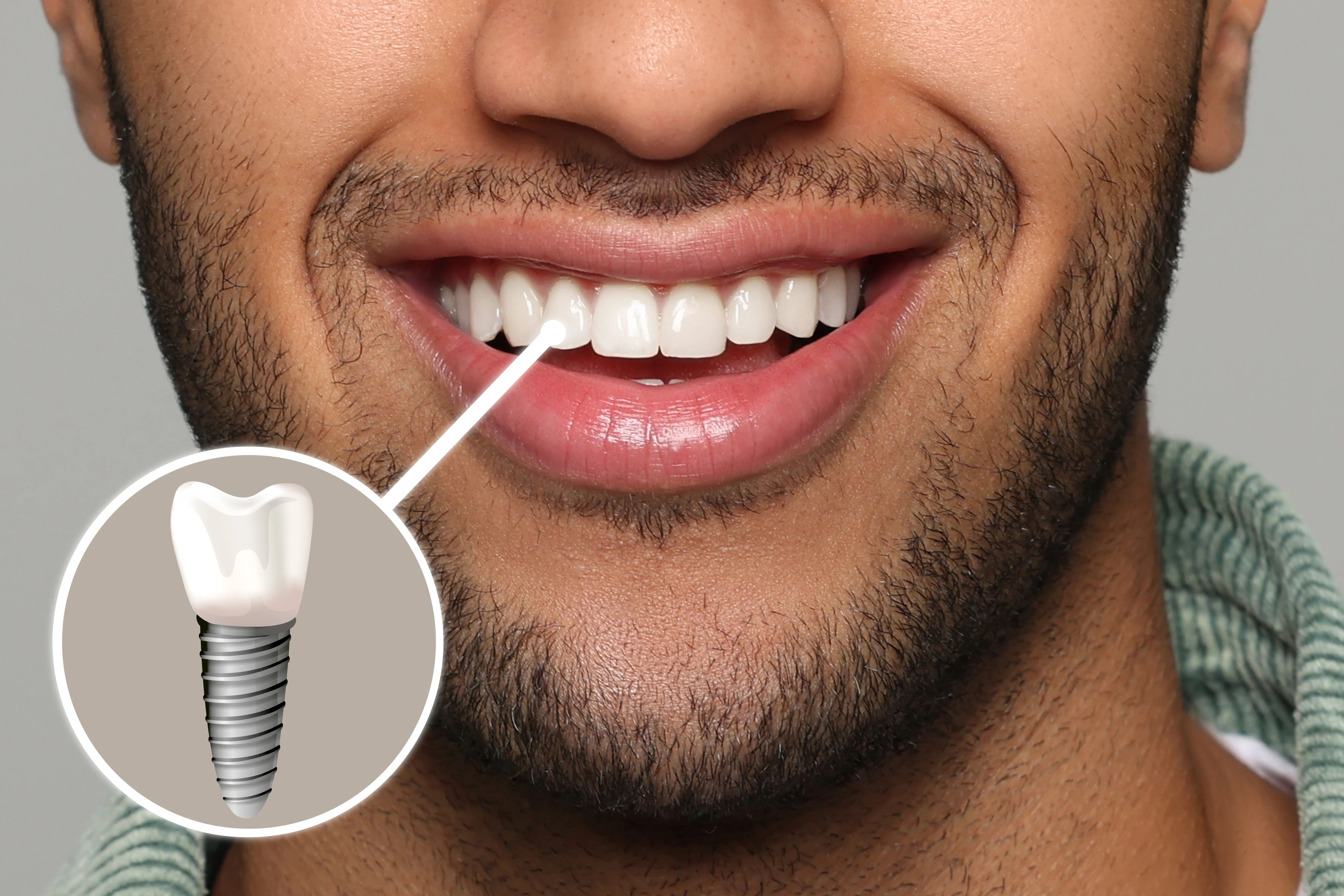Dental Care Dental Implants for Fixed Teeth—Fast
Know about dental implants, who needs it, step by step procedure, who qualifies, recovery, long-term care, risks and prevention and more.

Written by Dr. J T Hema Pratima
Reviewed by Dr. D Bhanu Prakash MBBS, AFIH, Advanced certificate in critical care medicine, Fellowship in critical care medicine
Last updated on 22nd Oct, 2025

Introduction
If you’ve lost a tooth or even several, dental implants can give you fixed teeth that look, feel, and function like the real thing. As part of your dental care plan, a dental implant replaces the tooth root with a small titanium or zirconia post, then supports a custom crown, bridge, or full-arch prosthesis. Thanks to modern imaging, guided surgery, and stronger materials, many people can get temporary teeth the same day as surgery and finish treatment faster than ever.
We’ll cover recovery, long-term maintenance, success rates, costs, and smart ways to choose the right dentist. You’ll also see how implants compare with bridges and dentures, plus evidence-backed tips to prevent complications. Whether you’re researching your first implant or considering a full-arch makeover, this practical overview will help you make confident, informed decisions about your dental care and your smile.
Understanding Dental Implants
Dental implant details include:
What a dental implant is (implant, abutment, crown)
A dental implant is a biocompatible post placed in your jaw to act as an artificial tooth root. After healing, a connector (abutment) links the implant to a custom restoration—a crown for a single tooth, or a bridge/full-arch prosthesis for multiple teeth. Implants are anchored directly in bone, which helps preserve jawbone shape and allows strong chewing forces, unlike removable dentures that rest on gums and can shift. When properly placed and maintained, implants are one of the most durable tooth replacements available.
Consult Top Dentist Doctor for Personalised Advice
How implants differ from bridges and dentures
Function and feel: Because implants integrate with bone, many people say they feel closer to natural teeth than removable dentures.
• Jawbone health: Implants stimulate bone when you chew, helping counteract bone loss after tooth loss. Conventional bridges and dentures don’t stimulate bone in the same way.
• Adjacent teeth: Implant crowns don’t rely on neighbouring teeth for support, so healthy teeth aren’t ground down as with traditional bridges.
• Stability: With full-arch implant solutions (e.g., All-on-4), people often regain a firm bite and clearer speech compared with loose dentures.
Materials: titanium vs zirconia
Titanium is the most widely used implant material thanks to its strength and decades of clinical success. Hypersensitivity is uncommon. Zirconia implants offer a metal-free alternative, which some patients prefer for aesthetics or biocompatibility. However, long-term data for zirconia is still growing, and not all clinical scenarios are suitable. Your dentist will recommend the material based on anatomy, bite forces, and aesthetic demands.
Are You a Candidate for a Dental Implant?
Oral health, bone density, and gum status
Ideal candidates have healthy gums, adequate bone volume, and good dental care habits. Severe gum disease is treated first, and areas with bone loss may need grafting to support the implant. Cone-beam CT (CBCT) scans help your dentist assess bone width/height and plan a safe, precise placement.
Medical factors: diabetes, smoking, medications
1. Diabetes: Well-controlled diabetes can be compatible with successful implants; uncontrolled blood sugar increases infection risk and slows healing. If you’re unsure about your control, consider checking HbA1c. Apollo24|7 offers convenient home collection for tests like HbA1c to support safe treatment planning.
2. Smoking: Smoking roughly doubles the risk of certain implant complications and can reduce success rates; quitting before and after surgery improves outcomes.
3. Medications and conditions: Drugs affecting bone metabolism (e.g., some antiresorptives), head/neck radiation, immune suppression, or bruxism (teeth grinding) may influence timing or technique. Your provider will review your medical history thoroughly.
When your dentist may recommend bone grafts or sinus lifts
If the jawbone is thin or short, bone grafting augments the site. In the upper back jaw, a sinus lift raises the sinus floor to create space for implants. These procedures add time but often enable long-term success.
Implant Options and “Teeth-in-a-Day”
Endosteal, mini, and zygomatic implants
Endosteal implants: The standard root-form implants are placed within bone.
Mini dental implants: Narrower implants sometimes used to stabilise dentures when bone is limited; they can be useful but aren’t a universal substitute for standard implants.
Zygomatic implants: Extra-long implants anchored in the cheekbone for severe upper-jaw bone loss; used in select cases by specialist teams.
Immediate placement and immediate loading (“same-day teeth”)
Immediate placement: Implant is placed at the same visit as tooth extraction.
Immediate loading: A provisional crown/bridge is attached the same day (no chewing on hard foods initially). According to Cochrane reviews, immediate loading can achieve similar survival rates to conventional loading in carefully selected cases, provided implants achieve good primary stability and patients follow aftercare instructions. Not everyone is a candidate—quality bone, bite forces, and implant stability all matter.
All-on-4/All-on-6 full-arch solutions
For people missing many or all teeth, 4–6 implants can support a full-arch bridge, often with a same-day provisional “fixed” set of teeth, then a definitive set after healing. These “teeth-in-a-day” plans can reduce treatment time and avoid removable dentures during healing, but they require experienced planning and maintenance commitment [3,8].
Step-by-Step: From Consultation to New Teeth
The steps include:
Assessment, CBCT scans, and digital planning
• Consultation and imaging: Your dentist evaluates your gums, bite, and bone with X-rays and CBCT for 3D planning. Digital scans of your teeth help create a surgical guide to place implants with precision [2,4].
• Treatment plan: You’ll review options (single implant vs bridge, All-on-4, mini implants), timing (immediate vs delayed), grafting needs, and costs. You should receive a written plan outlining visits and responsibilities.
Surgery day, healing, and osseointegration
1. Surgery: Often done with local anesthesia, sometimes with sedation. The implant is placed using a guide or freehand technique. Many people return to normal routines within 24–48 hours, with minor swelling or bruising [2–4].
2. Healing: Bone integrates with the implant over several weeks to months (osseointegration). Immediate temporaries may be placed on the same day in selected cases; otherwise, a healing cap protects the site.
Provisional vs final crown timelines
-ingle teeth: A provisional crown may be placed for aesthetics while you heal; the final crown is typically attached after 8–12 weeks (varies with bone quality and location) [2].
Full-arch: A same-day provisional bridge is common with All-on-4 protocols; the final prosthesis is crafted after tissues stabilize and the bite is fine-tuned—often at 3–6 months.
Recovery and Long-Term Dental Care
The recovery and care path includes:
First 72 hours: pain control, diet, and hygiene
Expect mild soreness and swelling for 1–3 days. Use prescribed pain relievers as directed; cold compresses can reduce swelling in the first 24 hours. Eat soft, cool foods initially (yogurt, eggs, soups), avoid straws and smoking, and keep your head slightly elevated the first night. Begin gentle rinsing (e.g., with saline) as advised. If swelling worsens after day 3, fever develops, or bleeding persists, contact your dentist. If symptoms persist beyond two weeks, consult a doctor online with Apollo24|7 for further evaluation.
Daily care: brushing, interdental cleaning, water flossers
1. Twice-daily brushing with a soft brush around the implant and gumline is essential.
2. Interdental brushes and floss/threaders or superfloss help clean under and around implant crowns and bridges. Many patients find a water flosser helpful to disrupt plaque, especially around full-arch prostheses.
3. Professional cleanings every 3–6 months are important. Your hygienist may use non-metal instruments and special polishing pastes to protect implant surfaces.
Recognizing early signs of peri-implant problems
Early signs include redness, swelling, bleeding on brushing, bad taste, or tenderness. These may indicate peri-implant mucositis (gum inflammation). Treated early, it’s reversible. If plaque and inflammation progress, bone supporting the implant can be lost (peri-implantitis), which is harder to treat. Prompt professional care helps prevent long-term damage.
Success Rates, Risks, and How to Avoid Complications
Lets see how to avoid complication
Survival rates (5–10 years) and what affects them
Well-placed implants show high survival—often 94–98% at 5–10 years—with variations based on jaw location, patient health, and maintenance [2,5,8]. Risk factors include uncontrolled diabetes, smoking, heavy bite forces/bruxism, poor oral hygiene, and active gum disease. Night guards can protect against grinding-related stress; tobacco cessation improves outcomes.
Peri-implant mucositis and peri-implantitis
Systematic reviews report peri-implant mucositis affects roughly 43% of patients and peri-implantitis about 22% of patients at the implant level, though estimates vary by definition and population [10]. Prevention hinges on plaque control and regular recalls. Treatments range from professional debridement and antiseptics to surgical interventions. Early detection is key—bleeding around an implant is not “normal.”
Alternatives: bridges, partials, full dentures
- Fixed bridge: Good option when adjacent teeth need crowns, but it requires preparing neighboring teeth and doesn’t stimulate bone.
- Removable partial/full dentures: Lower upfront cost; may need adhesives and periodic relines; can affect taste and speech for some. Implants can also stabilize dentures for improved function (e.g., two-implant overdenture).
- Resin-bonded bridge (Maryland bridge): Conservative for some front teeth if bite forces are light.
Lifetime value and cost-of-ownership
While implants can have a higher upfront cost, their longevity and ability to help preserve bone often make them a strong long-term value. Consider maintenance costs and replacement cycles of alternatives when comparing lifetime costs. A well-maintained implant can outlast multiple conventional bridges or dentures.
Choosing the Right Implant Dentist and What’s Next
The right implant dentist choosing procedure includes:
Credentials, experience, and implant systems
Look for providers with specific training in implant surgery/restorations (e.g., oral surgeons, periodontists, prosthodontists, or GPs with advanced implant education). Ask:
1. How many implants they place/restore annually
2. Their success and complication management rates
3. The implant systems they use and availability of parts long term
4. Sterilization protocols and how they handle guided surgery and follow-up [1,5,8]
Digital dentistry, guided surgery, and 3D printing
Digital planning with CBCT and intraoral scans allows precise implant positioning and custom, 3D-printed surgical guides. Many clinics also 3D print provisional prostheses for same-day solutions. Custom-milled abutments and CAD/CAM zirconia bridges enhance fit and strength. These innovations can reduce chair time and improve accuracy.
Conclusion
Dental implants have transformed modern dental care by offering fixed, lifelike teeth that can restore chewing power, clear speech, and confidence. With careful planning, some patients can even walk out with temporary teeth the same day, then receive their definitive restorations after healing. Still, long-term success isn’t automatic—it depends on excellent daily hygiene, regular professional maintenance, and smart lifestyle choices like quitting smoking and controlling blood sugar,
As you consider your options, weigh the benefits of implants against alternatives such as bridges or dentures, and think about lifetime value rather than just upfront cost. The right dentist will tailor a plan to your anatomy, health, and goals; use 3D imaging and guided surgery where helpful; and give you a clear roadmap for aftercare. If you have medical considerations like diabetes, it’s wise to coordinate with your physician; Apollo24|7 offers convenient home collection for tests such as HbA1c, which can support safe implant planning. If any post-op symptoms worry you or persist beyond the usual recovery window, consult a doctor online with Apollo24|7 for timely advice.
Consult Top Dentist Doctor for Personalised Advice
Consult Top Dentist Doctor for Personalised Advice

Dr. Debarati Deb
Dentist
10 Years • BDS, MDS Oral Medicine and Radiology
Kolkata
Dr. Smile Multispeciality Dental Clinic, Kolkata

Dr. Anupama Kumari
Dentist
7 Years • BDS, MDS (Conservative Dentistry & Endodontics)
Chhapna
RA Dent Clinic, Chhapna

Dr. Tamanna Nahid
Dentist
5 Years • BDS
Kolkata
Gajanan Multispeciality Clinic, Kolkata

Dr. Gourab Paul
Oral and Maxillofacial Surgeon
5 Years • BDS,MDS(ORAL AND MAXILLOFACIAL SURGERY)
Kolkata
SOLACE OF SOULS(SOS) HEALTH CARE, Kolkata
(50+ Patients)
Dr. Bristi Nath
Dentist
5 Years • BDS
Kolkata
SOLACE OF SOULS(SOS) HEALTH CARE, Kolkata
Consult Top Dentist Doctor for Personalised Advice

Dr. Debarati Deb
Dentist
10 Years • BDS, MDS Oral Medicine and Radiology
Kolkata
Dr. Smile Multispeciality Dental Clinic, Kolkata

Dr. Anupama Kumari
Dentist
7 Years • BDS, MDS (Conservative Dentistry & Endodontics)
Chhapna
RA Dent Clinic, Chhapna

Dr. Tamanna Nahid
Dentist
5 Years • BDS
Kolkata
Gajanan Multispeciality Clinic, Kolkata

Dr. Gourab Paul
Oral and Maxillofacial Surgeon
5 Years • BDS,MDS(ORAL AND MAXILLOFACIAL SURGERY)
Kolkata
SOLACE OF SOULS(SOS) HEALTH CARE, Kolkata
(50+ Patients)
Dr. Bristi Nath
Dentist
5 Years • BDS
Kolkata
SOLACE OF SOULS(SOS) HEALTH CARE, Kolkata
More articles from Dental Implants
Frequently Asked Questions
1) How long do dental implants last?
With good dental care and regular checkups, many implants last 10–20 years or longer. Studies report high 5–10 year survival rates, especially when risk factors like smoking are controlled and peri-implantitis prevention is prioritized.
2) Can I get same-day dental implants and teeth?
Some candidates qualify for immediate dental implant placement and “teeth-in-a-day” .provisional restorations. Success depends on bone quality, implant stability, and bite forces. Your dentist will assess with a CBCT scan and digital planning.
3) What does dental implant aftercare involve?
Follow dental implant aftercare instructions: soft diet initially, gentle brushing after 24 hours, interdental cleaning, and possibly a water flosser. Avoid smoking and attend 3–6 month maintenance visits to prevent peri-implantitis.
4) Are dental implants better than bridges?
Both can be excellent. Implants don’t rely on neighboring teeth and help preserve bone; bridges may be faster or cost less upfront but require preparing adjacent teeth and don’t stimulate bone. Discuss pros and cons for your case.
5) What increases the risk of implant failure?
Smoking, uncontrolled diabetes, poor oral hygiene, heavy grinding, and untreated gum disease increase risk. Manageable steps—quitting smoking, wearing a night guard, and regular professional cleanings—can reduce complications.


